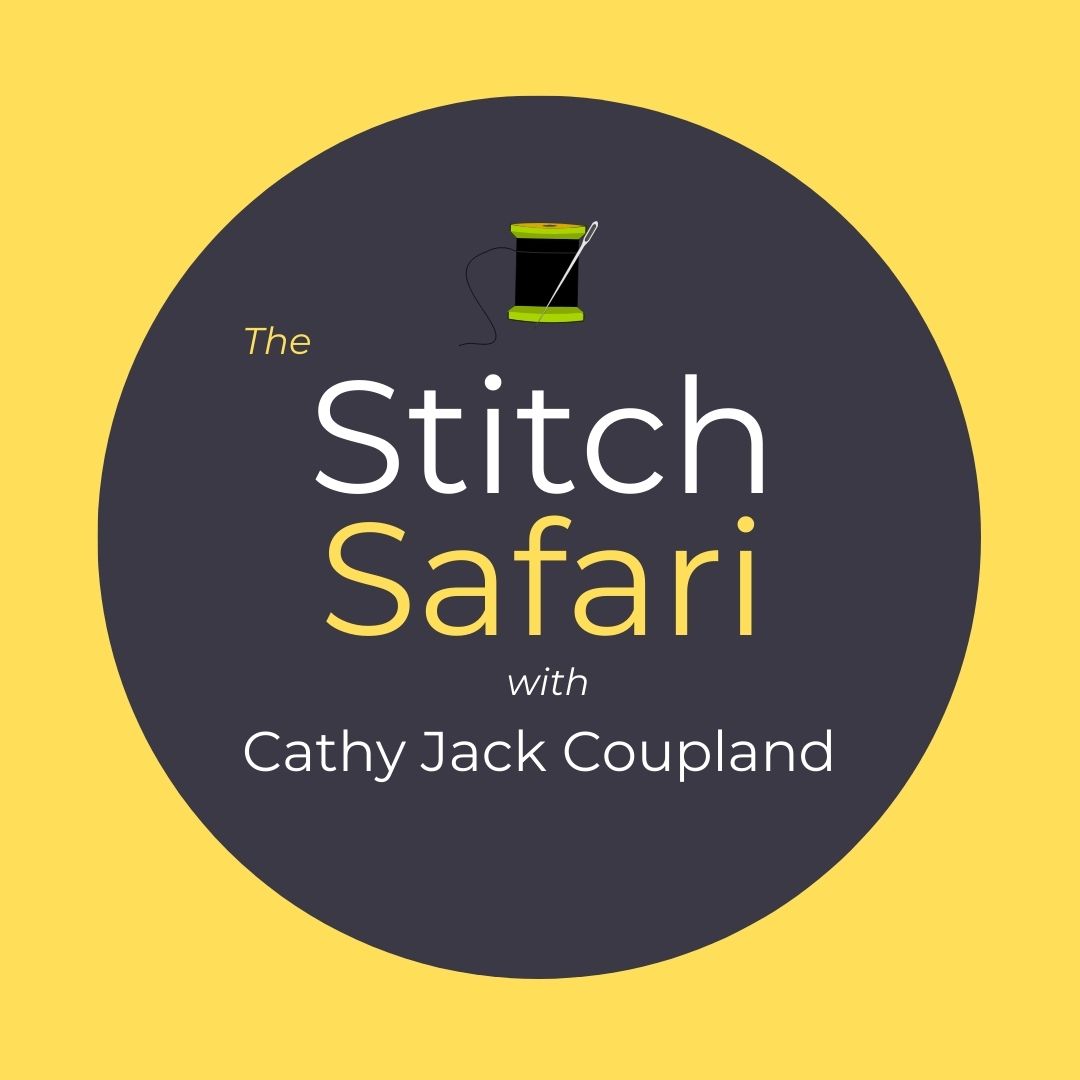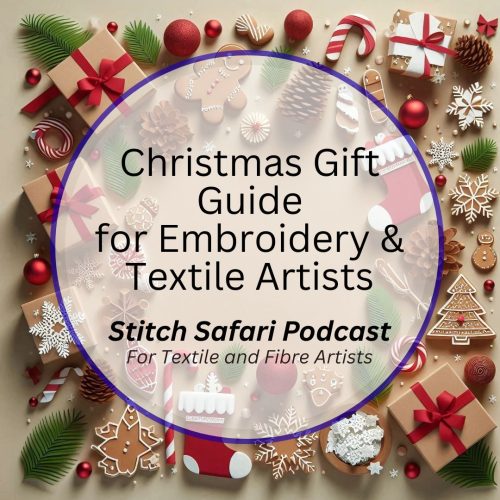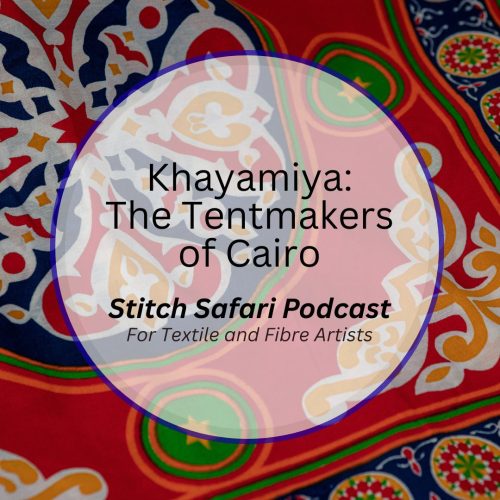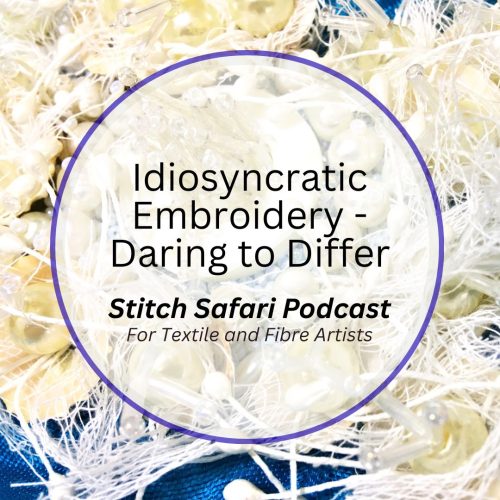DynamiThis episode of the Stitch Safari Podcast is the first in a series entitled ‘Dynamic Embroidery’.
Embroidery is so much more than merely creating a pattern or a pretty bucolic scene.
It’s an art form that adheres to the same practices, principles and devices as all other art forms – and that’s exactly what I want to demonstrate with this Dynamic Embroidery series.
And the first in this amazing series deals with the Power of Texture.
Yes, I’m referring to the feel, touch, appearance, and the finish of our work, known as visual texture, but also referred to as optical or implied texture.
Because we’re surrounded by texture, our sense of touch and feel allows us to perceive and interact with the world around us, enabling us to make sense of our world, to comfort, inspire and warn of danger.
Visual texture is the illusion of texture created through visual cues such as light, shadow, perspective and colour, rather than the actual surface feel of the embroidery.
In other words, we as embroiderers try to make a surface look as it should feel.
I love how this plays with our minds – it’s not what we can feel, it’s what we see that emulates what we would expect to feel.
The purpose of this Dynamic Embroidery series is to explore specific aspects of embroidery that support it as a vibrant, energetic, vital, and even feisty art form throughout its history, techniques, narratives, and evolving boundaries.
Each episode will delve into a specific theme or concept featuring artists, historical references and creative inspiration.
This episode explores texture in embroidery and the power it exudes in giving embroidery its tactile magic.
With its ability to transform surfaces and function as both an aesthetic and storytelling device, it provokes curiosity, invites touch, and deepens our visual experience.
And texture is one of the most evocative, transformative elements in the world of embroidery.
In this episode of the Stitch Safari Podcast, I plan to unravel the many layers of texture in embroidery and uncover how we use texture in embroidery to build dimension, emotion and narrative.
Let’s explore the multiple elements of texture in embroidery together, through one of my favourite devices.
Now, unlike tactile texture, something we can feel, visual texture is wholly perceived by sight, giving the impression of depth and detail in a two-dimensional world.
So it’s not what we see, but what we’re made to feel.
Techniques such as shading, line work, and varying colour values are used to infer different textures that can make a surface appear rough, smooth, shiny, spiky or bumpy.
These are all common art techniques, but embroiderers can emulate these just as easily, if not better than fine art artists, allowing for a more realistic representation of the world around us, adding that all-important visual interest and complexity to our work.
Texture can also lift off the surface of the ground fabric, creating shadows, movement and dimension, enabling storytelling without words.
This is where a stitch isn’t just a stitch; it’s where the surface becomes a story.
Dense loops of French Knots, the reflective shimmer of metallic threads, or the soft, delicate fray of raw silk, these are textures that hold the power to connect hand, eye and heart in remarkable ways.
It’s a tactile language that entices us visually – as it has done for centuries.
So within the definitions of texture, we have physical, also known as actual or tactile texture, where an object or artwork can be felt through touch, visual, where the illusion of texture is perceived through sight, and lastly, emotional texture, referencing how our emotions feel either in our bodies or our environment. This is a subjective or personal experience that combines the physical sensation of touch with the emotional responses it evokes.
But what about the psychology of touch? Why are we drawn to textured surfaces?
This is a fascinating topic because we all react to textures so differently.
We’re drawn to textured surfaces because of the visual and tactile richness that engages our senses and evokes an emotional response within us. Our brains are naturally wired to appreciate the complexity and irregularity of surfaces, finding them more interesting and stimulating than flat ones. This one point should be remembered and utilised throughout all our work.
The depth and dimension of textured surfaces create shadows and highlights, capturing our attention and making the surface more engaging.
The variety and detail of visual patterns prevent monotony, making surfaces or spaces more dynamic.
Then there’s our connection with nature and its many textures that evoke a calming or grounding effect.
This is an amazing analysis of just what embroidery is capable of.
Next, we move on to sensory engagement, where our sense of touch is powerful, providing a tactile experience that can be both pleasurable and informative.
But different textures can evoke specific emotions that suggest comfort and safety, while other textures stimulate, challenge and warn of danger.
There’s also the physicality and presence of texture, making things appear more real.
Psychologically, our curiosity is piqued by novelty and intrigue – it draws us in and encourages exploration, but then we also have textures that can trigger positive memories and feelings of nostalgia.
So texture is linked to an emotional response within us, and its appeal lies in the engagement of multiple senses, visual interest and creating emotional connections, making the surfaces more engaging and memorable than plainer ones.
That now makes a whole lot more sense to me.
I came across a great post by Jami Konarski Davidson on his NewLifePhotos blog from 2022 that’s well worth reading. Accompanied by stunning photography displaying examples of visual texture that we try to translate into our embroidery.
But wait, there’s more.
Texture can be used as a form of mark-making and self-expression, allowing artists to imbue their work with both visual and tactile qualities that can convey depth, emotion and storytelling. This diverse range of textures adds richness and visual interest to their work.
And it’s these marks that convey emotion, whether loose or gestural, precise or controlled, that can reveal their emotional intention.
This is the time to explore a diversity of materials and techniques that can push boundaries and offer unique mark-making possibilities to create dynamic, expressive embroidered art.
These marks can tell stories and communicate ideas using either representational or abstract imagery to convey narratives, themes and messages.
So texture can be used as a powerful form of mark-making, allowing the artist to communicate visually and emotionally with the viewer, at the same time providing a means of personal expression and experimentation.
Now, what are the materials and methods we can use to include visual texture in our work?
Immediately, my mind travels to the feel of velvet, satin and silk. The rich nap or pile as you brush your hand across sensuous velvet, the beautiful lustre and drape of satin, and the sound and gentle whisper of exotic, elegant silk. These are sensual, physical feelings that we also devour with our eyes.
All are wonderful textures to stitch onto, but there’s also linen, cotton, plaids, printed and novelty fabrics that can help begin to tell a very interesting and textural story.
Then there’s a world of thread, including metallic, fuzzy, novelty and synthetic that help build and support that story.
Now we move on to techniques such as French Knots, Bullion Stitch, couching, padded stitches, smocking, trapunto, and even thread painting, that just keep adding visual texture, visual interest and energy to the narrative.
But we haven’t finished yet. What about the density of stitch, stitch direction and playing with tension to create dimensional effects that help make the work so much more interesting?
I’m going to go back to the work of the Australian embroiderer, Aimee Estacourt. Her vibrant use of colour and clever shading creates the appearance of dimension. The use of stitch direction and even the juxtaposition of threads to create visual interest is quite amazing. Areas that are densely stitched mixed with other areas that are left bare evoke a sense of realism, especially when referencing bees on flowers. Then there’s that unexpected use of small areas of cross stitch alongside straight stitches that is just so quirky and right somehow. It’s exquisite work, and it’s the texture and contrast of textures, colour, stitch direction and even techniques that make Aimee’s work sing.
That’s what texture and contrast can do.
Let’s not forget the work of another Australian embroidery artist, Meredith Woolnough, who uses her sculptural embroidery technique on soluble fabric to explore the fragility of nature. Her work is delicate, lacy, expressive, and colourful, but it’s the texture of the stitch that captures the senses.
But hidden within the use of texture in embroidery are echoes of the past as we travel back through history to Elizabethan stumpwork, Goldwork embroidery on Ecclesiastical garments, the richly ornamented work of Indian Zardozi, along with Kantha work and the beautiful Japanese Sashiko work.
Then there’s the role of protection in history through the use of padded armour. Gambesons were a common form of padded armour in Medieval Europe, used as a standalone defence or under other armour. Constructed from multiple layers of linen, often with wool or other materials sandwiched between the stitched layers.
These quilted Gambesons offered effective protection from cuts, blows or piercing – the thicker the Gambeson, the greater the protection.
Examples of padded armour can be seen in the famous 11th-century embroidery, the Bayeux Tapestry.
But what of texture as Abstraction, and one artist comes immediately to mind is Jessica Wolodkiewicz, who creates the most amazing dimensional embroidery accented by clay shapes to create her unique style that is so distinctive and individual.
And one of my all-time favourite English embroidery artists, Marian Jazmik, who combines her love of embroidery and walking to create artworks that abound and delight with the abundance and elegance of texture. Study her work. It’s truly memorable.
Referencing Modern and Postmodern textile art sees texture playing a crucial role in enhancing the visual and tactile experience. It conveys meaning and adds depth to the work, creating diverse textures to evoke specific emotions or ideas.
Approaches in the Postmodern era of the 50’s and 60’s began to incorporate found objects, unconventional materials and experimental techniques. These challenged traditional notions of textile art and its relationship with body and space.
Modern textile art encourages viewers to engage with the artwork on both a visual and tactile level. This then fosters a greater connection and appreciation of the work.
There’s also a diversification and experimentation with various materials and techniques. Weaving, embroidery, felting and quilting all create their unique textures and patterns, allowing some artists to create dimensional artwork that pushes the boundaries of traditional textile art.
Look at the work of Nina Kratz, who writes on her website: ‘More than ever we yearn for meaningful bonds, true intimacy and being connected to something bigger than ourselves…In the end, we’re all bound together by the desire for love and belonging.’
Her work expresses those values so explicitly through her fabric-tying technique, exploring tension, movement, and bold textures. All are the core of her practice.
Conceptual, performance and installation art explores themes of memory, community, and resistance, where the texture of the textiles interacts with the body and the surrounding environment.
Texture’s vital role in modern and postmodern textile art provides artists with a powerful tool that encompasses both visual and tactile expression, as well as emotional communication, challenging traditional uses of various media.
So when we touch embroidery, we evoke an experience – it may be a memory, comfort or a connection, but it stirs something within us to react – and that’s something all artists can utilise in their art.
I hope this provides a deeper understanding of the power of texture in embroidery as an artistic device and a technique that enables and supports storytelling.
This would be a great time to begin sampling traditional techniques using unusual threads and fabrics, just to analyse outcomes that could be useful to you. And as you work, new ideas do have a way of popping into your consciousness.
It’s also a time to revisit and appreciate how texture was used historically in embroidery. Study the Bayeux Tapestry, Raised Work, how different cultures used texture in their work to express status and tell stories, as well as how it was used to add decorative flair to clothing, furnishings and religious objects.
Research and appreciate these historical traditions, then apply your interpretation to them using modern materials, and constantly consider how you can utilise embroidery in dimensional and tactile ways.
Texture in embroidery can elevate the ordinary, turning it into a living surface of story and sensation – really, what more could you ask from a simple needle and thread?
So whether you’re a novice or seasoned embroiderer, pay close attention to those layers, lumps, bumps, ridges and ripples in your work because they have the power to transform your art.
Remember, stitch boldly because the most powerful stories are those we can feel.





